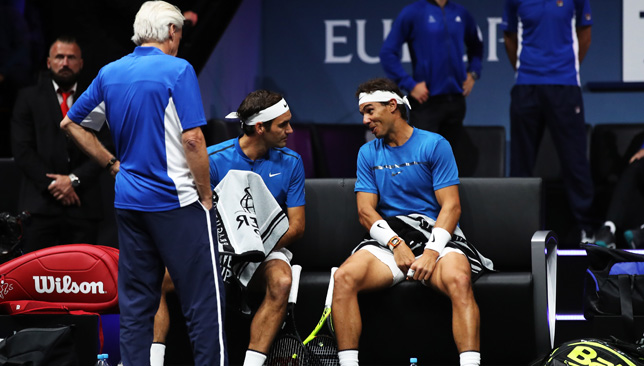
It’s fair to say that no one expected the inaugural Laver Cup to be this successful, not even Roger Federer himself – the man behind the new team event that took Prague by storm last weekend.
There was so much scepticism surrounding the Laver Cup prior to its first edition. People wondered if the players would be invested in it, if the competition would be serious, if the fans would show up and if the idea of Team World v Team Europe would foster an actual rivalry.
Federer himself admitted he was concerned about how team members would get along and whether the team spirit would be there from the start.
The ecstatic reaction of Team Europe when Federer sealed a 15-9 victory for them, and the tears of Nick Kyrgios when he lost that match tiebreak to the Swiss said it all.
With over 83,000 fans showing up over three days, and five sold-out sessions at the impressive O2 Arena, the Laver Cup took everyone by surprise and made a massive statement in its first year.
Here are the biggest takeaways from the action in Prague.
Speaking to Team World captain John McEnroe after the event was over, it was undeniable how emotional the American was feeling.
“I’ve been around a lot of things, a lot of incredible Davis Cup scenarios, it’s hard to feel like you could top this,” said McEnroe, who at one point during the last match between Kyrgios and Federer, just stood up and started raising his arms wildly at the crowd, in an effort to get them behind the team.
Nadal looked like a nervous wreck when Federer was losing to Kyrgios, who cried after he suffered a narrow defeat that ended his team’s comeback.
“You didn’t let us down,” Denis Shapovalov told Kyrgios during the post-match press conference.
The matches were very competitive, and John Isner played the tennis of his life when he defeated Nadal on Sunday to cut Team Europe’s lead to just three points.
And almost all of them said they’d love to be involved next year, assuming they qualify by ranking.
“We even kind of joked before the matches started that, you know, everyone wants to be in the top-six for next year’s event. It’s extra motivation in the rankings,” said Sam Querrey.
“Everything about the event has been amazing. You can’t really think of one thing to change or make better. It’s just been first class with every aspect of the event.”
With matches played over best-of-three, and the third-set being a 10-point tiebreaker, organisers made sure the clashes did not drag on forever.
The fact that matches on day one were worth one point, the ones on day two were worth two points and on day three were triple points meant that the tournament got progressively more competitive and ensured there were no dead rubbers on Sunday.
Having teams alternate the right to answer with their own line-up based on the other team captain’s picks for the day was also a cool touch.
Choosing a city that loves sport but one that does not host any ATP tournaments was a strategic move that paid dividends.
Still cant get over how packed the O2 Arena has been all day. You’ve done well, Prague! pic.twitter.com/NUWhWp1JBb
— Reem Abulleil (@ReemAbulleil) September 22, 2017
The O2 Arena was at full capacity every session and it’s hard to imagine a better start for the Laver Cup. Chicago will play host next year – another sports-mad location that has no local professional tournaments.
One thing the tournament probably missed is a partisan crowd. With 60 per cent of the tickets sold to people from outside the Czech Republic, it was a very mixed audience in Prague last weekend, and while they were loud and tennis-savvy, it didn’t feel like Team Europe had the home court advantage. That is something that will probably take some time to build as the event gains more traction and people get used to the idea of a ‘Team Europe’ and a ‘Team World’.
The chemistry between the players while watching their team-mates courtside, and the behind-the-scenes footage revealed on social media were arguably the most compelling parts of the Laver Cup, and they drew in the casual fans as much as the die-hard ones.
Borg: You can play from both sides?
Nadal: “Yes… I don’t care” #versatility[🎥: @LaverCup] pic.twitter.com/btJ8ma7fzD
— Reem Abulleil (@ReemAbulleil) September 23, 2017
Tennis often comes off as a very sterile sport and it’s insight like that that can give it a breath of fresh air. Watching Sascha Zverev cool down on a bike while following his team-mates’ matches, or seeing Nadal and Federer mess around between clashes was must-see TV. We need to see more of that throughout the year from the tour.
While I refuse to equate Davis Cup to Laver Cup, the latter has certainly given us a glimpse of what the former is currently lacking – and that is star power. The biggest names in the sport continue to skip Davis Cup ties, which means the inter-nation competition keeps losing lustre and relevance.
Perhaps it’s time to ditch the whole four-times-a-year format and think about having Davis Cup staged over one week each year – or even better, every two years? After all, it’s easier to commit to something when it’s once a year, rather than four.
#NCR199 on Laver Cup! What made it so successful so fast, and what can Davis Cup learn from it? With @reemabulleil: https://t.co/LYyQxyP7Hs
— NCR Tennis Podcast (@NCR_Tennis) September 27, 2017